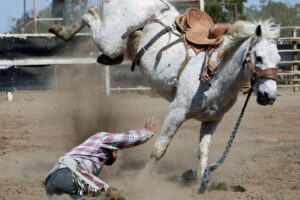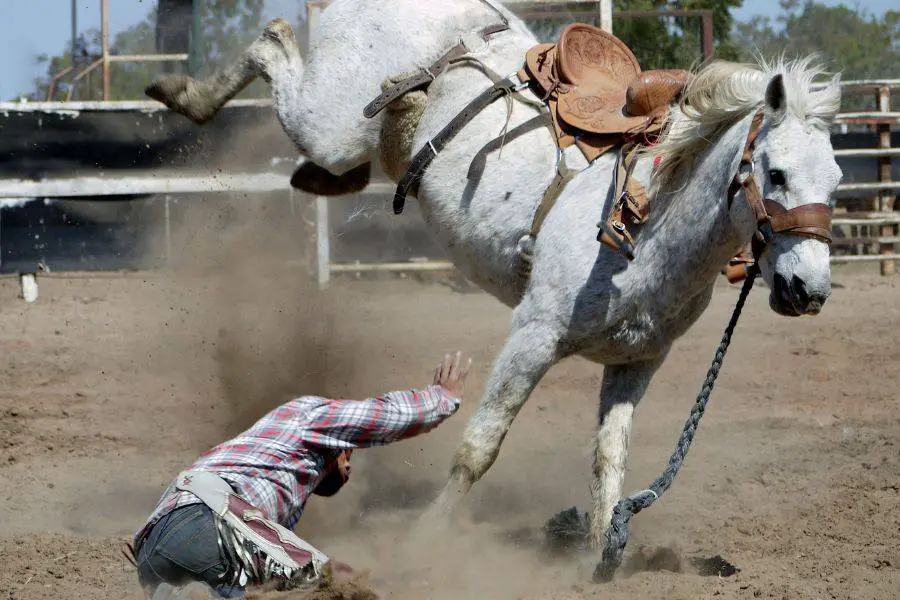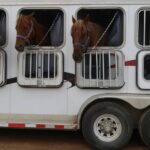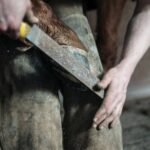Table of Contents
It’s not uncommon for a horse to step on your toes.
This often happens because you didn’t react quickly enough to avoid getting in the way.
Even the most experienced horse owners occasionally find that they cannot move their feet at the same rate as their horses.

This can sometimes result in bruising, abrasions, and even broken bones.
Walking on your fingers while cleaning hooves is possible, but it is a very remote possibility.
If you fall, there is a chance that the horse will step on you.
Nevertheless, in most cases, the horse will try to avoid doing so.
In this article, we will be discussing everything about horse stepping on your toes.
Why Do Horses Step on Human Toes?
The truth is, a horse will not purposefully step on a human being.
Walking through a sacred herd of horses will result in you being knocked to the ground.
However, every horse in the herd will try to avoid stepping on you.
This is not an act of charity; rather, they attempt to prevent themselves from tripping or injuring their legs.
They try to steer clear of shadows on the ground for several reasons.
One of the reasons is the risk of breaking a leg.
They can be taught to trample things on purpose and step on a snake.
However, they will not do this while running away.
If you were forced to choose between being thrown in front of a herd of cattle or a herd of horses, you should always go with the horses.
And sometimes, the horse might be preoccupied with something other than you and wasn’t paying attention.
Your job requires you to be aware of distractions.
If you notice they are inattentive, you need to stay out of the way.
You either point it out and rectify it or leave to stay out of danger.
You should ensure that your horse has a level of respect for you.
This will prevent him from breaching your personal space even when excited.
In addition, this provides some insight into the interaction between the rider and the horse.
Most of the horses that have stepped on people were preoccupied with something else and were not paying attention.
What to Do to Prevent a Horse From Stepping on You
One of life’s greatest pleasures can be found in the ability to work with horses and ride them.
They are powerful animals that can be wary and must be handled appropriately.
Always take precautions to avoid injuring yourself or the horse.
Do this by adhering to safe riding procedures on the ground and while astride the animal.
Here are ways to avoid a horse stepping on your toes.
Put On Short Boots With a Zipper With No Steel Toes
If a horse was to step on a pair of steel-toed boots, the metal in the front of the boot might cut into the wearer’s toes.
Choose boots made of tough leather to safeguard your feet from the possibility of a horse stepping on them.
Tennis shoes or boots made of supple leather offer no protection for your feet.
Ensure your boots have a heel if riding (usually about 2″ high).
Do not dress in boots that require laces. It will be difficult to remove the hooks from the stirrups.
There is a broad range of variations in weight based on the size and breed of your horse.
The average range is between 880 and 1,870 pounds (400 to 850 kg).
Even a fourth of the weight on your toes is quite substantial.
Therefore, you must exercise caution while selecting safe boots.
Put on Safe and Noticeable Clothes
It is best to avoid loose clothing while riding, as it may become entangled in the horse’s equipment.
Before you ride near roadways, the most important thing you can do is make sure you can be seen easily.
Wearing fluorescent vests is strongly encouraged, particularly in settings where there is severe rain, fog, or poor light.
Wear a Body Protector
If you are just starting as a rider or in a competition, ensure you wear a body protector.
The protection must be comfortable and no more than five years old.
Sores and discomfort can be avoided by wearing seam-free undergarments, legwear, and comfortable gloves.
You must get approval from an agency that sets safety standards.
Inspect the Tack Regularly
Make sure that all tacks have the appropriate dimension and form for the horse.
Examine every piece of tack for signs of wear and tear.
This includes the leather showing any signs of cracking or stretching, as well as the quality of the stitching.
Anything on the verge of breaking or cracking potentially threatens one’s safety.
Check everything once more after you’ve ridden for a short distance, then mount.
The cinch should be snug enough to prevent the horse from trapping its leg.
However, it shouldn’t be so tight that it causes the animal discomfort.
You shouldn’t have to drape the reins over the horse’s neck or wind them around your hand to grasp them properly.
Repeat the check after you have mounted and after a long ride every few hours.
Maintain First Aid Kits for Both Humans and Horses
Unplanned events like a horse stepping on you can happen anytime.
Maintain at least one of each item at your stables for safety.
If your horse travels frequently, keep an additional item in the trailer with him.
Include a piece of strong paper containing the contact information for a nearby veterinarian, human hospital, and horse ambulance.
Ensure that someone in the vicinity knows basic first aid for humans and horses.
Put In Latches That Are Resistant to Horses
Many horses can figure out how to open straightforward locks and sliding bolts.
Think about using an eye bolt and/or a horse-proof latch that can be purchased.

If you have a horse that is either very bored or highly intelligent, you should install multiple latches and/or a wooden shelf to prevent the horse from reaching the latch.
If your horse is often attempting to get away, he could require additional companionship, exercise, or fresh air.
You don’t want a horse hurting a stranger by stepping on them.
Keep One Hand on the Horse as You Watch It From a Distance
Your hands are the most important communication between you and a horse.
You should rest your hand on the horse’s shoulder or hindquarters when cleaning the horse.
Even though the horse cannot see you, he will know that you are there because of this.
Additionally, it allows you to push yourself away from the horse if it decides to step on you.
Stand next to the horse’s side and keep at least one hand on it when grooming or tacking up.
Pay close attention to any unexpected increases in the level of tension.
This may escalate to a kick or a lunge.
What Happens if a Horse Step on Your Dog
You should always be careful with your dog if there’s a horse nearby. This is especially important with smaller dog types.
They are more likely to become entangled between the legs of a horse.
Small dogs have a higher risk of broken toes since a herd of horses tends to walk on them accidentally. Toe bones are quite fragile due to their size.
If you suspect your dog has a fractured toe because a horse stepped on them.
You should take the dog to a veterinarian who can diagnose the fracture using X-rays.
They may also feel the foot to determine whether they can identify which toe is broken.
X-rays of the foot are normally quick and painless, making it possible to receive a diagnosis in minutes rather than hours.
A cast or a splint may be used to immobilize the broken bone in the foot until it can heal.
This will depend on which toe in the foot was broken.
In extremely unusual cases, the broken bone may require surgery to insert a pin to hold it together.
It is common practice to offer painkillers and anti-inflammatory drugs to a dog with a broken toe. This helps the animal feel better.
A dog with a fractured toe needs to have some activity limits placed on them to recover as rapidly as possible.
Running and jumping should be prohibited since they could prevent the bone from healing correctly.
In addition, antibiotics may be administered if the fracture is accompanied by an open wound, which increases the risk of infection.
To avoid all this stress for your dog, always ensure they are far away from a horse.
Keep them in different locations and always monitor them.
Using baby gates and exercise pens may be necessary to prevent a dog and a horse from being together.




